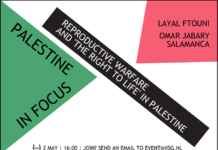Nada Homsi
The National / August 1, 2023
Residents of Lebanon site fear escalation could lead to Lebanese army intervention.
A ceasefire to end days of deadly clashes in Lebanon’s largest refugee camp for Palestinians, Ain al-Hilweh, has failed to deter heavy fighting between rival factions which has killed 11 people and caused thousands to flee their homes.
“The ceasefire is in name only but it’s not the reality on the ground,” said a member of the Popular Committees, a committee of representatives of the political factions that de facto govern the camp.
“There was a brief lull in the fighting yesterday evening that continued into the morning,” he said on Tuesday, speaking on condition of anonymity. “But by afternoon the fighting was as bad as it was yesterday, if not worse.”
Some of the camp’s residents told The National they feared the Lebanese army could intervene should the fighting continue or spread outside the camp, although the official said it was “too early for that kind of talk”.
At least two thousand people have fled their homes during clashes in the alleys and streets of the overcrowded camp, the UN Relief and Works Agency for Palestinian Refugees (UNRWA) said, while 11 people were killed in the fighting and dozens injured, it added.
The so-called ceasefire was established on Monday evening with Lebanese mediation following heavy fighting between a number of Islamist insurgent groups and Fatah, the most powerful faction in the camp.
Ola, a homemaker living near the camp, told The National by phone that clashes had persisted despite the ceasefire. The sound of shelling could be heard in the distance as she spoke.
“I don’t dare to leave the house yet,” she said. “And if the ceasefire breaks down and things get worse, I’ll try to get my family to leave the area.”
She said she and other camp residents were fearful of a potential intervention by the army, adding that she had seen an army reconnaissance plane hovering over the camp overnight.
The Lebanese military does not typically enter the refugee camps due to a decades-long agreement with the Palestinian factions who run them.
“But if shells fall on them or the fighting extends outside the camps, who knows?” Ola said. “The army might try to subdue the clashes themselves.”
A security source in the Lebanese army did not deny the possibility of intervention but said it was unlikely.
“Until now [the Lebanese army] isn’t entering,” he said. “Fundamentally, entry into the camp isn’t that simple. For now, we’re at the gates and we’ve closed off all the entrances from every side.”
For more than a decade, Ain al-Hilweh, notorious for harbouring criminals and Islamist militants, has been the site of a power struggle between a network of militant extremists and the Fatah movement’s security apparatuses.
Although clashes are not uncommon, this week’s battles were especially ferocious.
“There needs to be some sort of political agreement,” camp resident Talal Aboujamous said, expressing concern that the ceasefire is only temporary.
“An understanding should be reached because we, the people living here, are paying the price for all the fighting.”
The US State Department called on all factions to respect the safety of civilians and private and public property, including schools and healthcare facilities, following the “alarming reports of escalating violence” in the camp.
“We are especially concerned by reports that the violence damaged at least two schools operated by UNRWA,” spokesman Matthew Miller said.
Assassination trigger
The heavy violence first erupted Sunday after the killing of Fatah official Abu Ashraf al-Armoushi, in charge of security in the camp, and four of his bodyguards on Sunday, in what the group called a “heinous assassination operation”.
That killing was preceded by a failed assassination attempt on an extremist leader on Saturday, which left one person dead.
The killing of Al-Armoushi and the subsequent clashes were an attempt by “extremist terrorist groups” seeking to “pass external plans and agendas aimed at striking the state of stability and peace that the Palestinian camps in Lebanon are witnessing”, Fatah’s security forces said in a statement on Monday.
The assailants were identified as members of the militant Islamist group Jund al-Sham “and takfiri gangs”, according to the commander of the Palestinian National Security Forces in the Lebanese Camps, Maj Gen Subhi Abu Arab.
An audio recording of a commander of Jund al-Sham, Haitham al-Shaabi, accusing the rival Fatah group of breaking the ceasefire was circulating on Tuesday afternoon as clashes intensified.
“They opened fire and opened on us from all fronts,” he said. “Until now there have been no more injuries on our side.”
The recording was verified by the member of the Popular Committees as authentic.
Lebanon’s refugee camps have for decades sheltered Palestinians forcibly expelled from their land during what they refer to as the Nakba, or catastrophe, which saw the creation of Israel in 1948.
Ain al-Hilweh holds more than 50,000 registered refugees, many of them from coastal towns in northern Palestine, now northern Israel.
Notably, it is also home to some of the 30,000 Palestinian refugees displaced from the Nahr al-Bared camp in 2007 during 15 weeks of fighting between the Lebanese army and Islamist extremists, which saw the destruction of the camp.
About 500,000 registered Palestinian refugees live in 12 camps across Lebanon, although the actual number is believed to be closer to 200,000 because many Palestinians emigrate from Lebanon but remain registered through UNRWA.
Nada Homsi is a correspondent at The National’s Beirut bureau
________
Despite truce, violent clashes resume in Palestine refugee camp in Lebanon
Middle East Monitor / August 1, 2023
Despite a cease-fire agreement, violent clashes resumed in Ain al-Hilweh Palestinian refugee camp in southern Lebanon on Tuesday, Anadolu Agency reports.
The largest of 12 Palestinian refugee camps in Lebanon, the Ain al-Hilweh camp located near Sidon city, has been witnessing clashes since Saturday. The clashes between Islamic groups and Palestinian security forces affiliated with the Fatah movement left 11 people dead and more than 40 others injured, according to UN figures.
Clashes erupted again on Tuesday, despite a cease-fire reached late Monday after communications between Lebanese and Palestinian officials.
The Lebanese army is working to tighten surveillance and inspection at all entrances to the camp and is patrolling its vicinity, asking citizens not to approach the roads leading to the area.
Sidon city was also affected due to some stray bullets and rockets while thousands of people were displaced from their homes in the camp.
Established in 1948, Ain al-Hilweh is the largest Palestinian refugee camp in Lebanon with 50,000 registered people, according to figures released by the United Nations, while unofficial statistics put the camp’s population at 70,000 people.
The total number of Palestinian refugees in Lebanon is estimated at about 200,000, distributed among 12 camps, most of which are under the control of the Palestinian factions.



![vrijdag 17 mei in Amsterdam: in gesprek [videoverbinding] met Palestijnse arts Ghassan Abu-Sittah](https://palestina-komitee.nl/wp-content/uploads/2024/04/abu-Sittha-1-1-218x150.png)








